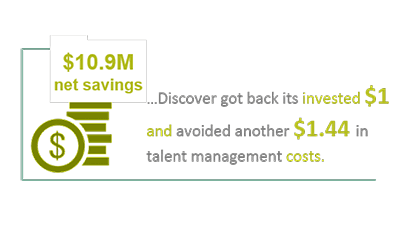Every year, employers spend about $177 billion on formal education and training for their employees, with about $28 billion of that spending in support of tuition benefits. Almost 60 percent of employers offer tuition assistance or reimbursement to employees, which is tax-free to employees up to $5,250 and can be claimed as a deduction on the employer’s taxes.
These programs have typically been viewed by employers as a benefit, in the same category as health insurance and paid leave. Many HR and talent leaders don’t even think about tuition assistance programs as key strategies for talent development. Employees’ participation in these programs reflects this view. On average, only 2-5 percent of eligible employees use tuition assistance programs, and 43 percent of working adults are unaware if their employer offers such a program.
Low use and awareness of programs can often be traced back to business leaders who are hesitant to advertise the program and increase employee participation. On the flip side, employers can be hesitant to promote or grow their programs because of low participation. And while tuition assistance programs can help employers to fill talent and skill gaps, many business leaders are unsure that the benefits of these programs justify their cost.
“It’s a poor financial investment.”
At most, only 5 percent of employers do any kind of measurement of the return on their talent investments. Yet employers spend millions of dollars every year on tuition assistance programs. In an environment where every dollar is scrutinized and stretched, this is surprising.
Still, it is understandable that employers could be reluctant to increase or promote their investments in talent. There is a real fear that employees, once they have completed a credential, will move on to greener pastures. Also, attaining a higher education degree or credential takes more time than most employer-provided training, and therefore often doesn’t result in immediate impact.
Lumina Foundation, in partnership with Accenture, recently conducted a series of five studies with leading U.S. employers—including Cigna, Advocate Health Care and Discover Financial Services—to evaluate the return on investment (ROI) of tuition benefits programs. The studies examined the employer benefits of investing in tuition assistance by determining the differences in promotion, transfer, retention and absenteeism rates for employees who did and did not participate in these programs. The studies also controlled for other factors, such as job function or age that could impact findings.
The studies found that tuition assistance consistently results in a strong financial investment. All of the employers in the study series achieved a positive ROI from their programs, and two of the employers, Discover and Cigna, achieved extraordinary results—144 percent and 129 percent ROI, respectively. For each dollar invested in these programs, not only are employers getting back their original dollar, they are achieving talent management cost savings that go well beyond the investment cost.
“We already invest and don’t want to spend any more money.”
Many employers are already spending significantly every year on tuition programs. Spending more money actually isn’t necessary.
The study series showed that employers, once aware of the return they are receiving from their investments, are eager to make changes that transform these benefit programs into strategic talent initiatives. And these transformations do not necessarily require new resources.
For example, as a result of the ROI study, Cigna took action to shape its tuition assistance program and focus it on the organization’s talent needs. Cigna increased its annual, per participant financial support to $10,000 for undergraduate degrees and $12,000 for graduate degrees in fields of study that are key to the company’s skills needs. Correspondingly, Cigna lowered its assistance levels for degrees in non-strategic fields.
In this way, Cigna will continue to experience the positive returns for their investments in talent, but will use its resources to improve its long-term talent outlook, without incurring significant new costs.
“If we pay for employees to get a credential, they’ll leave.”
Every HR and talent professional has heard the story: A CFO asks a CEO, “What happens if we train our people and they leave?” The CEO responds, “What happens if we don’t train our people, and they stay?” It’s a funny, poignant way of making a point: Without education and training, employees won’t have the skills they need to be more productive, climb the ranks, and continue to be assets for the company. But the suspicion still remains: Educated employees are competitive job-seekers.
The good news is that, consistently, the ROI studies found that turnover decreased among employees who participated in tuition assistance programs. This attrition decrease was even more pronounced among workers on the front line, where job turnover is highest. For example, employees participating in the Education Assistance Program at Advocate Health Care, the largest healthcare system in Illinois, were up to 3 percent more likely to be retained than employees who did not participate in the program. Cigna experienced even greater benefits, with program participants 8 percent more likely to be retained than their peers.
Further, employees who participate in tuition assistance programs not only stick around longer, they also climb the ranks at a higher rate. At Discover, workers who used tuition assistance were a staggering 21 percent more likely to be promoted.
Bottom Line
The evidence is clear: Tuition assistance programs pay for themselves in reduced talent management costs. These programs support employee talent development and result in real cost savings for employers. For more information, see the Talent Investments Pay Off study series.
Related:
Degreed Co-Founders Raise $3.5 Million to Help Employees Take Training Sabbaticals | EdSurge | April 21, 2020
